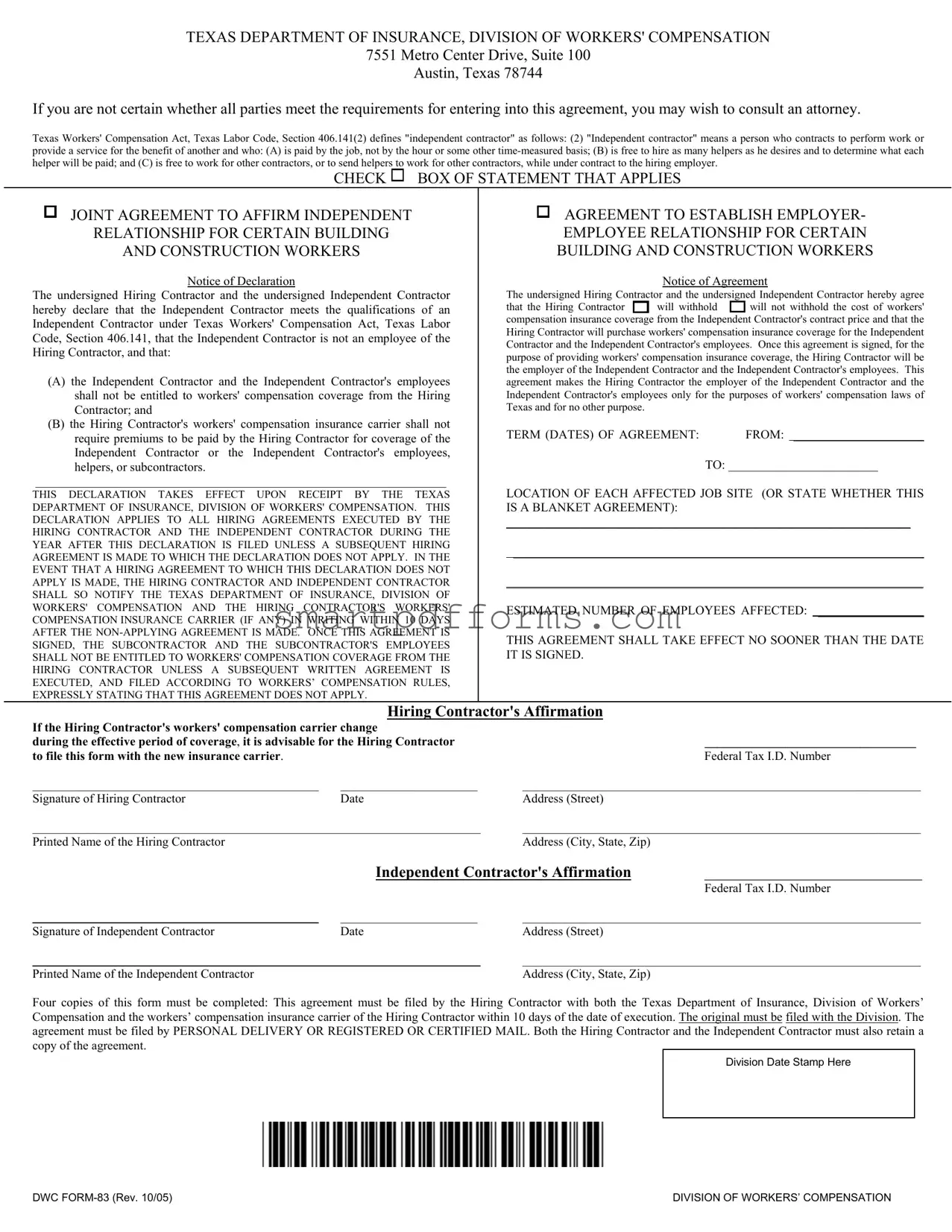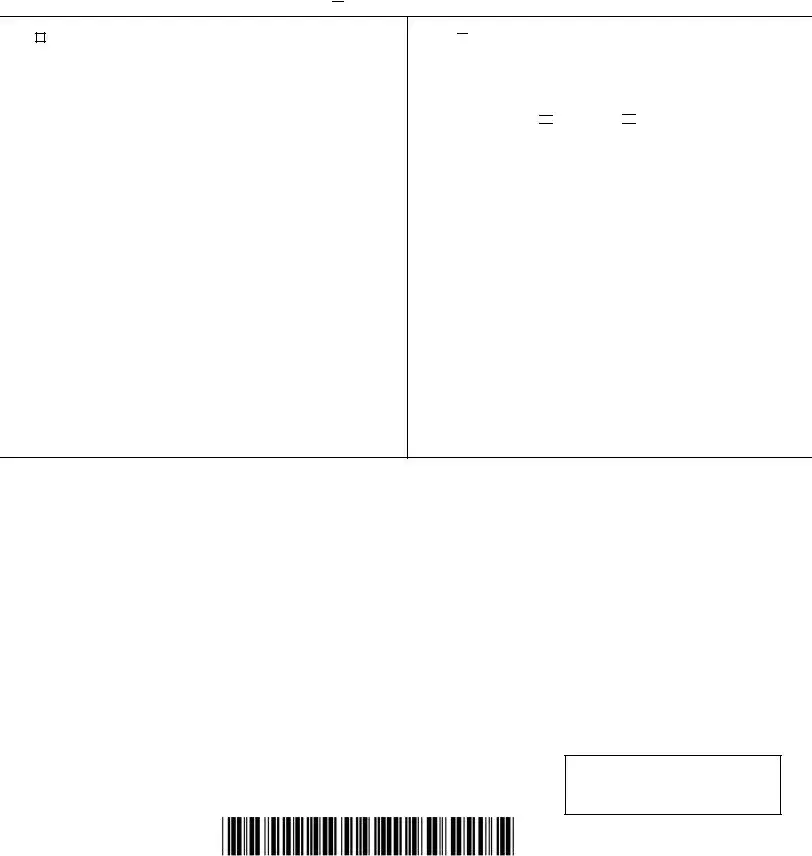What is a DWC 83 form in Texas?
The DWC 83 form is an official document used within the Texas Workers' Compensation system. It serves two primary purposes: to affirm an independent relationship between a hiring contractor and an independent contractor for certain building and construction work, or to establish an employer-employee relationship for the same parties for the purposes of workers' compensation insurance. This form highlights the agreement's terms, including coverage details, the identity of the parties involved, and specific job site locations. Once filed, it dictates whether the independent contractor and their employees will or will not receive workers' compensation coverage from the hiring contractor.
Who needs to file a DWC 83 form?
Both hiring contractors and independent contractors engaged in building and construction work in Texas may need to file a DWC 83 form. This form is essential for those who wish to clearly define their working relationship concerning workers' compensation insurance. It's particularly relevant when contractors choose not to cover independent contractors and their employees under their workers' compensation insurance policies.
How and when should the DWC 83 form be filed?
The DWC 83 form must be completed and filed by the hiring contractor with both the Texas Department of Insurance, Division of Workers' Compensation, and the hiring contractor's workers' compensation insurance carrier within 10 days of the agreement's execution. The original form should be sent to the Division, and it's recommended to use personal delivery or registered or certified mail for filing. Importantly, both the hiring contractor and the independent contractor must keep a copy of the agreement for their records.
What are the implications of signing a DWC 83 form?
Signing a DWC 83 form has significant implications for both parties involved. For independent contractors and their workers, signing the form as an affirmation of independent contractor status means they will not be entitled to workers' compensation coverage from the hiring contractor. Conversely, if the form is signed to establish an employer-employee relationship, the hiring contractor agrees to provide workers' compensation coverage to the independent contractor and their employees, but only for the duration and under the conditions specified in the agreement.
Can a DWC 83 agreement be modified or terminated?
Any change to the working relationship defined in a DWC 83 form requires notifying the Texas Department of Insurance, Division of Workers' Compensation, and the hiring contractor's workers' compensation insurance carrier in writing within 10 days after making a non-applying agreement. This means if the parties enter into a new agreement that changes the status of the independent contractor (from not covered to covered by workers' compensation insurance, or vice versa), both entities need to be informed promptly.
What happens if a DWC 83 form is not filed correctly?
Failing to file a DWC 83 form correctly or within the specified timeline may result in the independent contractor being classified as an employee by default, thereby requiring the hiring contractor to provide workers' compensation coverage. This could lead to financial or legal complications, including penalties for non-compliance with the Texas Workers' Compensation Act. To avoid such issues, it's crucial to fill out and file the form accurately and promptly.
Where can I find a DWC 83 form or get help filling it out?
The DWC 83 form is available through the Texas Department of Insurance, Division of Workers' Compensation website. For assistance in filling out the form correctly, consulting an attorney familiar with Texas workers' compensation laws is advisable. Additionally, the Division of Workers' Compensation offers resources and guidance that can help both hiring contractors and independent contractors understand their rights and responsibilities under the law.



 BOX OF STATEMENT THAT APPLIES
BOX OF STATEMENT THAT APPLIES
 AGREEMENT TO ESTABLISH EMPLOYER- EMPLOYEE RELATIONSHIP FOR CERTAIN BUILDING AND CONSTRUCTION WORKERS
AGREEMENT TO ESTABLISH EMPLOYER- EMPLOYEE RELATIONSHIP FOR CERTAIN BUILDING AND CONSTRUCTION WORKERS
 will withhold
will withhold 
 will not withhold the cost of workers' compensation insurance coverage from the Independent Contractor's contract price and that the Hiring Contractor will purchase workers' compensation insurance coverage for the Independent Contractor and the Independent Contractor's employees. Once this agreement is signed, for the purpose of providing workers' compensation insurance coverage, the Hiring Contractor will be the employer of the Independent Contractor and the Independent Contractor's employees. This agreement makes the Hiring Contractor the employer of the Independent Contractor and the Independent Contractor's employees only for the purposes of workers' compensation laws of Texas and for no other purpose.
will not withhold the cost of workers' compensation insurance coverage from the Independent Contractor's contract price and that the Hiring Contractor will purchase workers' compensation insurance coverage for the Independent Contractor and the Independent Contractor's employees. Once this agreement is signed, for the purpose of providing workers' compensation insurance coverage, the Hiring Contractor will be the employer of the Independent Contractor and the Independent Contractor's employees. This agreement makes the Hiring Contractor the employer of the Independent Contractor and the Independent Contractor's employees only for the purposes of workers' compensation laws of Texas and for no other purpose.